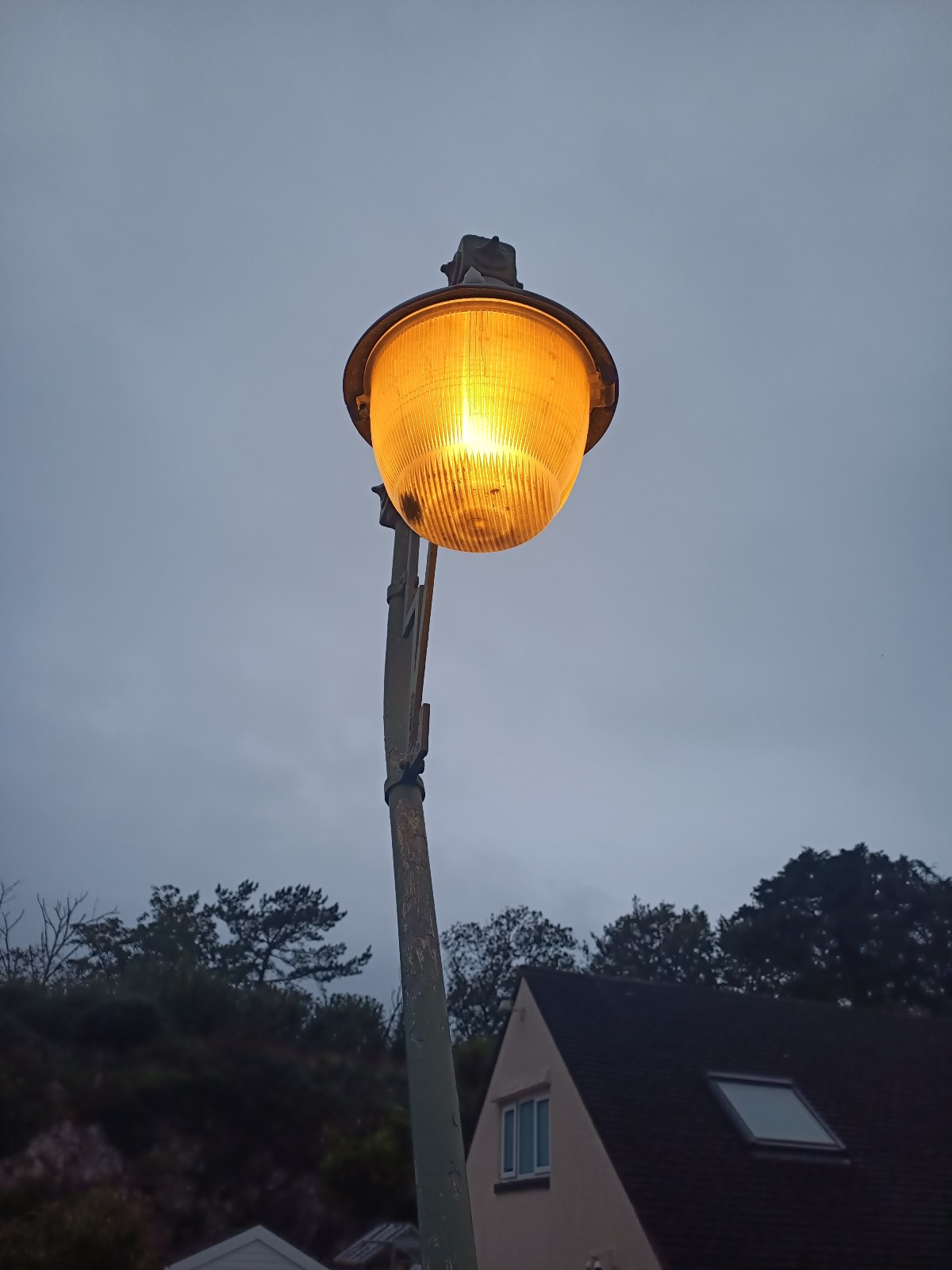Rose Hill Grove / Woodlands Close, Storth, Sandside, Beetham, Westmorland and Furness, Cumbria With thanks to Alan Hilton for informing me of these Survivors. Located on both of these short cul-de-sacs are a couple (one per road) of 10 ft (3·048 m) cast iron columns supporting top-entry Revo brackets of an unusual design. Unlike the conventional curved swan neck bracket, these feature a right-angled bend between the initial vertical section of pipe work, and the horizontal section that provides the outreach, with a finial installed at both this junction, and the one above the lantern. In both cases, the lanterns are Thorn Beta 4s, which are likely to have run 80 Watt MBF (mercury vapour) lamps originally, but are now converted to run 70 Watt SON / CDO-TT (high pressure sodium / ceramic metal halide) lamps instead.
The Beta 4s are not the original lanterns to be fitted to these brackets; the original 1930s' lanterns having been replaced in (approximately) the 1970s.
The bracket features a double-doored control box at its base - originally, one side would have housed the electricity supply fuse, with the time switch control being installed on the other. Today, the lamp control gear and two-part photocell relay will have been sandwiched (rather snugly, I would imagine) into the same enclosure.
An art deco 'lightning flash' design is fitted in the space created between the two sections of pipe. This isn't purely decorative; it will serve as a support for a heavy cast iron lantern, although the much lighter Beta 4 would place far less strain on the overall metalwork.
Helpfully, "Fuses" is cast into the front-facing portion of the control box; the plural being due to a fuse being connected to both the live and neutral terminals of electricity supplies when this installation was made. This method is no longer permitted, as the neutral fuse carrier could be pulled (or the wire within it could fail), leaving the equipment still live.
The top spike of the front finial is damaged; the surviving rear spike demonstrates how this would have looked when intact.
The polycarbonate refractor bowl has suffered considerable UV discolouration in its lifetime on the road. The detector for a Zodion SS55 two-part photocell is visible on the front-facing portion of the canopy.
Alan supplied the image below that features the lantern operating - the discoloured bowl gives the CDO lamp an appearance more akin to SON.

Much of the column on Woodlands Close is obscured by ivy that has climbed up it.
Both finial spikes remain intact here.
A plain bowl is fitted here, though this one too has become discoloured over time.
A part code is visible on this side of the ironwork.
Although the edges of the characters are softened by the paint, the code appears to be C108#. This does not, however, correspond to any brackets in Revo's 17th catalogue of c.1940, as the C1080-5 series were guards for bulkhead fittings, and C1086 onwards were various cast iron watertight light fittings.
As a bonus, Storth Road, further north of the above cul-de-sacs, is home to a single 15 ft (5 m) Stanton 1805-type concrete column near the junction of Park Road, which runs alongside the River Kent estuary.
An F-type top-entry concrete bracket is fitted.
The rear of the GEC Z559# series lantern's bowl has been painted black, to reduce the amount of light that can pass backwards, into the windows of adjacent properties.
The characteristic narrow profile of the 1805 column was what would go on to be the biggest design flaw with this column type - the minimal amount of concrete used in its construction making it more susceptible to structural cracking at base level than occurred on other columns with thicker walls.
From viewing the lantern from the other side, some slight damage to the bowl is visible, as is the Zodion SS55 two-part photocell detector.
This view inside the base compartment shows another slight issue with the 1805 design - the internal backboard is very narrow too, and the cut-out, photocell relay and Zodion Vizion electronic 70 Watt ballast only just fit the available width.
CLICK HERE TO MAKE A MONETARY DONATION
© 2002 - English Street Lights Online